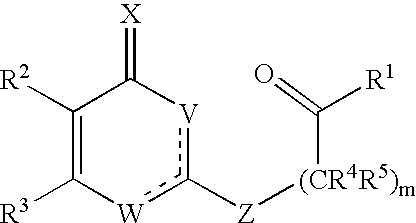Substituted heterocyclic compounds and methods of use
a heterocyclic compound and substitute technology, applied in the field of substituted heterocyclic compounds and methods of use, can solve the problems of small blood vessel adherence and significant neutrophil accumulation in capillaries
- Summary
- Abstract
- Description
- Claims
- Application Information
AI Technical Summary
Problems solved by technology
Method used
Image
Examples
example 1
[0127]
3-Methyl-2-methylsulfanyl-5-naphthalen-2-yl-6-pyridin-4-yl-3H-pyrimidin-4-one
[0128]To a stirring solution of ethyl-2-naphthylacetate (10.0 g, 46.7 mmol) and 4-cyanopyridine (4.86 g, 46.7 mmol) in 50 mL dry dimethylformamide (DMF) at room temperature under nitrogen was added 47 mL potassium tert-butoxide (1.0 M in 2-methyl-2-propanol) dropwise via syringe. The dark red solution was stirred at room temperature for 75 min. Methylthioisocyanate (3.41 g, 46.7 mmol) in 10 mL DMF added whole. The solution was stirred for 90 min at room temperature. Iodomethane (2.95 mL, 46.7 mmol) was added dropwise over a 3 min period. Solid precipitates out of reaction. Continued to stir as a mixture for 30 min. Water (500 mL) was slowly added to reaction mixture. The solid was collected via filtration then washed with water, cold ethanol (50 mL), and ether. The solid was air dried for 3 days. M+1=360.2.
[0129]
2-Hydroxy-3-methyl-5-naphthalen-2-yl-6-pyridin-4-yl-3H-pyrimidin-4-one
[0130]A suspension o...
example 2
[0143]
2-[3-(4-Methoxy-phenyl)-2-oxo-propylamino]-3-methyl-5-naphthalen-2-yl-6-pyridin-4-yl-3H-pyrimidin-4-one
[0144]To a stirring solution of 2-[2-hydroxy-3-(4-methoxy-phenyl)-propylamino]-3-methyl-5-naphthalen-2-yl-6-pyridin-4-yl-3H-pyrimidin-4-one (765 mg, 1.55 mmol) in 20 mL dichloromethane was added Dess-Martin Periodinane (660 mg, 1.55 mmol). The dark red solution was stirred for 18 h at room temperature. The reaction mixture was diluted with 80 mL dichloromethane and washed twice with 15 mL 5% sodium bicarbonate, and dried over magnesium sulfate. The product was purified on 40 g silica eluting with 0 to 4% methanol / dichloromethane to provide the product as a yellow foam. The product was further purified on reverse phase high performance chromatography using an water / acetonitrile (0.1% TFA) gradient. The final sample was lyophilized from 50% acetonitrile / water to give a yellow powder. M+1=491.2.
example 3
[0145]
2-[3-(4-Hydroxy-phenyl)-2-oxo-propylamino]-3-methyl-5-naphthalen-2-yl-6-pyridin-4-yl-3H-pyrimidin-4-one
[0146]To a chilled (0° C.) stirring solution of 2-[3-(4-methoxy-phenyl)-2-oxo-propylamino]-3-methyl-5-naphthalen-2-yl-6-pyridin-4-yl-3H-pyrimidin-4-one (250 mg, 0.21 mmol ) in 20 mL dichloromethane under an atmosphere of nitrogen was added boron tribromide (39 μL, 0.42 mmol) in 0.4 mL of dichloromethane. The resulting precipitate was stirred for 18 h warming to room temperature. The solvent was removed under reduced pressure, then the product was dissolved in 4 mL methanol. The product was purified on on reverse phase high performance chromatography eluting with a water / acetonitrile (0.1% TFA) gradient. The final product was lyophilized from 50% acetonitrile / water to give a yellow powder. M+1=477.2 NMR (CD3CN / D2O 3:1) s (3H, 3.40 ppm), s (2H, 3.60 ppm), s (2H, 4.25 ppm), d (2H, 6.51 ppm), d (2H, 6.95 ppm), d (1H, 7.22 ppm), m (3H, 7.4-7.5 ppm), d (2H, 7.5 ppm), d (1H, 7.72 pp...
PUM
| Property | Measurement | Unit |
|---|---|---|
| temperature | aaaaa | aaaaa |
| temperature | aaaaa | aaaaa |
| temperature | aaaaa | aaaaa |
Abstract
Description
Claims
Application Information
 Login to View More
Login to View More - R&D
- Intellectual Property
- Life Sciences
- Materials
- Tech Scout
- Unparalleled Data Quality
- Higher Quality Content
- 60% Fewer Hallucinations
Browse by: Latest US Patents, China's latest patents, Technical Efficacy Thesaurus, Application Domain, Technology Topic, Popular Technical Reports.
© 2025 PatSnap. All rights reserved.Legal|Privacy policy|Modern Slavery Act Transparency Statement|Sitemap|About US| Contact US: help@patsnap.com



